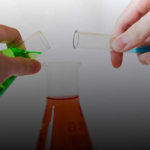Section 1
Preview this deck
Oxidation-Reduction reaction
Front
Active users
0
All-time users
0
Favorites
0
Last updated
5 years ago
Date created
Mar 1, 2020
Cards (57)
Section 1
(50 cards)
Oxidation-Reduction reaction
A reaction that results in the change of the oxidation states of some precipitating molecules.
Every reaction has a ______________ , or voltage associated with it.
electric potential
Oxidation number of alkaline earth metals
+2
Oxidation number of Halogens
-1
Reduction
An atom gains electrons, oxidation number decreases
Hydroxide formula
OH-
Endothermic reaction diagram
What are the two solubility rules you need to know for AP?
1. Compounds with alkali metal cation or an ammonium cation are always soluble 2. Compounds with a nitrate anion are always soluble
Cyanide formula
CN-
How do you calculate electric potential?
add the potential for the oxidation half-reaction to the potential for the reduction half-reaction Never multiply the potential for the half reaction by the coefficient
Oxidation number of oxygen
-2
Dichromate formula
(Cr2O7)2-
Acid-base Reaction
A reaction when an evidence reacts with a base to form water and salt
Enthalpy Change equation
Spectator ions
Ions that do not take part in the reaction They start out and end up as free ions
What are some important things to know when dealing with oxidation states?
1. The oxidation state of an atom that is not bonded to an atom of another element is 0. That means either an atom that is not bonded to any other atom or an atom that is bonded to another atom or the same element (O2) 2. The oxidation numbers for all the atoms in a molecule must add up to 0. 3. The oxidation numbers for all atoms in a polyatomic ion must add up to the charge of the ion.
Exothermic reaction
If the products have stronger bonds than the reactants, then the products have lower enthalpy than the reactants and are more stable; in this case energy is released by the reaction
Oxidation state
Indicates the number of of electrons that it gains or loses when it forms a bond.
Synthesis Reactions
When simple compounds are combined to form a single, more complex compound
Basic Rules of Enthalpy
When bonds are formed energy is released. When bonds are broken energy is absorbed.
Permanganate formula
(MnO4)-
How to solve a stoichiometry
1. Convert whatever you are given into moles. 2. The limiting reagent is not necessarily the reactant that you have the least of; it is the reactant that runs out first. 3. Use the balanced equation to determine how many moles of the desired product are generated. 4. Convert moles of product to the desired unit.
Phosphate formula
(PO4)3-
Decomposition
The opposite of synthesis. A reaction where a single compound is split into two or more simple compounds, usually in the presence of heat.
Oxidation
An atom loses electrons and the oxidation number increases
What happens to the reduction potential when a solid is placed into a metallic solution and a new solid forms?
The reduction potential of the metal in solution is greater than that of the solid.
Current
defined as the flow of positive charge, so current is always in the opposite direction from the flow of electrons
Oxidation number of alkali metals
+1
Acetate formula
(C2H3O2)-
Activation Energy Ea
The amount of energy need to reach the transition state. (Find textbook definition)
Catalyst
Speeds up reaction by providing the reactants with an alternate pathway that has a lower activation energy. Lowers activation energy for both forward and reverse reactions so it has no effect on equilibrium conditions.
Oxidation number of transition metals
Have several oxidation states which are differentiated from one another by a Roman numeral in the name of the compound.
Endothermic reaction
If the products have weaker bonds than the reactants, then the products have higher enthalpy than the reactants and are less stable; in this case, energy is absorbed by the reaction
How are electric potentials given?
reduction half reactions you can read them in reverse and flip the sign on the voltage to get oxidation potentials
Anode
where oxidation takes place
Precipitation
When yen aqueous solutions mix, sometimes a new cation/anion pairing can create an insoluble salt
Sulfate formula
(SO4)2-
Galvanic cell
also called voltaic cell a spontaneous redox reaction is used to generate a flow current
Oxidation-reduction reaction
Electrons are exchanged by the reactants, and the oxidation states of some of the reactants are changed over the course of the reaction.
Half reactions
Oxidation and reduction formulas written separately
Which is more likely to occur spontaneously? Endothermic or exothermic
Exothermic. All substances like to be in the lowest possible energy state, which gives them the greatest stability.
Nitrate Formula
(NO3)-
What happens in a galvanic cell?
Two half reactions take place in separate chambers and the electrons that are released by the oxidation reaction pass through a wire to the chamber where they are consumed in the reduction reaction
Enthalpy Change ΔΗ
The enthalpy of a substance is a measure of the energy that is released or absorbed by the substance when bonds are broken and formed during a reaction.
Ammonium formula
(NH4)+
Exothermic Reaction Diagram
What happens to the reduction potential if a solid is placed into a metallic solution and no solid forms?
The reduction potential of the solid is higher.
Oxidation number of group 3A
+3
Carbonate formula
(CO3)2-
Why do ionic substances dissolve in water?
The attraction of a h ions to the dipoles of the water molecules.
Section 2
(7 cards)


